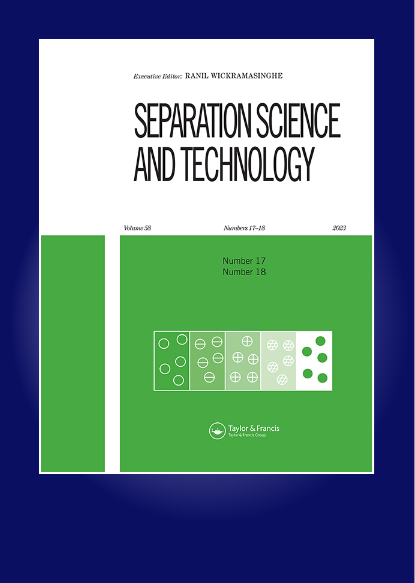Study of plutonium recovery from acidic feed using polyethersulfone encapsulating TBP, DEHPA, and mixture of TBP and DEHPA beads
IF 2.3
4区 工程技术
Q3 CHEMISTRY, MULTIDISCIPLINARY
引用次数: 0
Abstract
ABSTRACTPolyethersulfone (PES) composite beads encapsulating the extractants di-(2-ethylhexyl) phosphoric acid (DEHPA), tributyl phosphoric acid (TBP), and mixture of DEHPA & TBP were synthesized. The synthesis was carried out using phase inversion method. Subsequently, these PES beads were applied for the recovery of plutonium [Pu (IV)] from different aqueous acidic medium. In kinetic studies, the extraction of Pu (IV) was found to be fast and equilibrium was attained within 5 minutes. In batch sorption studies, the role of aqueous acidity and nitrate ion concentration on extraction efficiency was evaluated. Also, the effects of variation of acid medium, concentration of metal ion, extractant concentration were examined for Pu (IV) recovery. Back extraction was effectively carried out using oxalic acid. The reusability of the PES beads was tested for 10 extraction – stripping cycles.KEYWORDS: Polyethersulfone composite beadsDEHPATBPsorptiondesorptionnitric acidplutoniumsorption studies AcknowledgmentsAuthors acknowledge U. Dani, C.E, NRB, BARCDisclosure statementNo potential conflict of interest was reported by the author(s).聚醚砜包封TBP、DEHPA及TBP与DEHPA混球回收酸性饲料中钚的研究
摘要合成了包封萃取剂二(2-乙基己基)磷酸(DEHPA)、三丁基磷酸(TBP)及DEHPA - TBP混合物的聚醚砜(PES)复合微珠。采用相反转法进行合成。随后,将这些PES珠用于从不同的酸性水介质中回收钚[Pu (IV)]。在动力学研究中,发现Pu (IV)的提取速度快,在5分钟内达到平衡。在批量吸附研究中,考察了水溶液酸度和硝酸盐离子浓度对萃取效率的影响。考察了酸性介质、金属离子浓度、萃取剂浓度等因素对Pu (IV)回收率的影响。用草酸进行反萃取效果良好。对PES珠的可重复使用性进行了10次提取-剥离循环试验。关键词:聚醚磺酸复合化合物头dehpatb吸附解吸硝酸钚吸附研究作者致谢U. Dani, C.E, NRB, barc披露声明作者未报告潜在利益冲突。
本文章由计算机程序翻译,如有差异,请以英文原文为准。
求助全文
约1分钟内获得全文
求助全文
来源期刊

Separation Science and Technology
工程技术-工程:化工
CiteScore
6.10
自引率
3.60%
发文量
131
审稿时长
5.7 months
期刊介绍:
This international journal deals with fundamental and applied aspects of separation processes related to a number of fields. A wide range of topics are covered in the journal including adsorption, membranes, extraction, distillation, absorption, centrifugation, crystallization, precipitation, reactive separations, hybrid processes, continuous separations, carbon capture, flocculation and magnetic separations. The journal focuses on state of the art preparative separations and theoretical contributions to the field of separation science. Applications include environmental, energy, water, and biotechnology. The journal does not publish analytical separation papers unless they contain new fundamental contributions to the field of separation science.
 求助内容:
求助内容: 应助结果提醒方式:
应助结果提醒方式:


